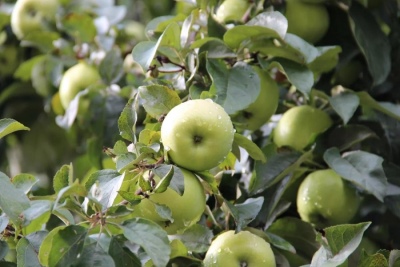
- Taste: sweet and sour
- Scent: thin
- Fruit weight, g: 80-100
- Fruit size: average
- Yield: at the age of 3 years harvest - 10 kg, after 5 years - 27 kg
- Frequency of fruiting: annual
- The beginning of fruiting varieties: for 3 years
- Ripening terms: summer
- Removable maturity: In the end of August
- Keeping quality: up to 3 weeks
The name of the Tiny apple tree should not be misleading. The prospects for its cultivation are by no means "tiny". However, for a good result, it is imperative to study all the nuances.
Breeding history of the variety
It is impossible to say who is the author or developer of Tiny. However, it is known that the distribution of planting material goes through the Siberian Garden nursery. The suppliers of the seedlings did not disclose any additional details.
Description of the variety
The crumb is indeed a compact plant. It is suitable for propagation by the root cut method. The apple tree looks neat. The branches go straight from below, above they bend under the weight of the fruit. In terms of consumer characteristics, the plant can successfully compete with a number of tall types.
Features, pros and cons
The top grows well thanks to young shoots. However, even a tall stock does not produce a tall tree. The branches are relatively small. Where they touch the soil, they can take root. The cultivar's weakness is its unsuitability for cold regions.
But then the apple tree:
visually beautiful and compact;
gives good results from a consumer point of view;
tolerates scab steadfastly;
gives yields of a universal nature.
Ripening and fruiting
The variety belongs to the summer group. You can shoot apples at the end of August. The first fruits are produced in 3 years. Fruit will appear annually. The frequency of fruiting has not been established. The plant is self-fertile and can be grown singly.
Yield
The baby is distinguished by serious fertility. One tree can grow 30-40 kg of apples per season. But to increase yields is obtained additionally if the crop is grown in a greenhouse method. It should be noted that the harvested apples cannot be stored for a long time. It is also very difficult to transport them.
Fruits and their taste
White-green apples The crumbs have a rounded shape and characteristic ribs. The mass of a single fruit is 80-100 g. The peel is rather thin. They also note:
sweet and sour taste;
white and juicy pulp with large grains;
guaranteed keeping quality up to 3 weeks;
delicate pleasant aroma.

Growing features
Since the Crumb is a bush apple tree, the approach to it is not the same as to ordinary tree crops. It is very important that the seedlings have:
well-developed large buds on the branches;
moist roots;
branching;
tags indicating all the necessary information;
well visible areas of the graft above the root collar.
Chernozem, loam, and sandy loam are suitable for Crumbs. It is necessary to choose a site protected from the wind and decently lit. Shading during the day, if acceptable, is for a short time. Landing in lowlands is completely unacceptable. Spring planting is preferable to autumn planting, because it helps the apple tree to strengthen and calmly survive the winter season.
If planting still takes place in the fall, then this must be done no later than mid-October.In areas with a severely unfavorable climate, the critical period still needs to be shifted. The occurrence of soil water is not critical. However, the drainage layer must be equipped in any case. Near Crumbs, it is recommended to plant bluegrass and fescue, which turn out to be ideal siderates.



Top dressing
It is necessary to add nutrients to the trunk circles every autumn. Around the perimeter of this circle, pits are formed with a depth of 25-35 cm. You need to put fertilizer there 14 days before the end of the leaf fall. Most often, 1.5 liters of ammonium nitrate are dissolved in a bucket (10 liters) of water. It is not necessary to use such a top dressing annually, but once in several seasons.

Frost resistance
Apple tree Tiny can survive the winter well. However, in areas with a harsh climate, a shelter created in the fall will definitely not hurt. 2 weeks before the approximate arrival of frost, the root zone should be mulched. The thickness of the laying is 20-25 cm. After the onset of freezing temperatures, the entire bush is protected with any suitable covering material.


The apple tree is a popular fruit crop among gardeners. It can be found in many summer cottages. But at the same time, such trees are often affected by various diseases. It is very important to recognize the disease in time and carry out the necessary procedures for a speedy recovery. Otherwise, the fruits will be spoiled, and the tree itself may die altogether.

Review overview
Problems with the apple tree Tiny sometimes arise. But this happens mainly in those gardeners who mechanically transfer agricultural technology to it, typical for tree forms. With the right approach, even frozen plants can usually be saved.The quality of the fruit, like the appearance, is liked by the vast majority of people. Everything depends on the methodology and skill of the gardeners themselves.











































































